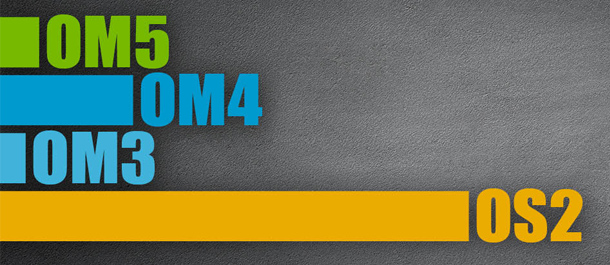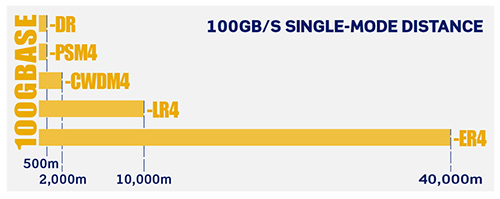Single-Mode Fiber Continues to Gain Momentum

Over the past several years, Leviton has polled network professionals about the type of fiber they would install today, and we have seen solid growth in single-mode. In fact, in the latest March 2020 poll of 281 network professionals, more than 60% said they would install single-mode (OS2) today over multimode types, with OM4 coming in second at 28%.
This change is largely a result of decreasing cost and recent standards committee activities that continue to promote more single-mode options for higher speeds such as 200 and 400 Gb/s. As this trend continues, the market in general will find single-mode a more enticing option. Let's take a closer look at reasons behind its rise.
CHANGE DRIVERS
As with most data center networking trends today, the hyperscale and cloud data center operators tend to be the ones driving change. Whether it be density, termination methods or infrastructure types, market leaders and high-profile companies offer techniques to mimic or avoid. But the sheer size of hyperscale facilities — along with the lightning fast speeds required to serve data center customers — have made the bandwidth and reach capabilities of single-mode the infrastructure of choice for new installations.
There was a time when single-mode transceivers were typically 7-8 times the cost of multimode. But the purchase volumes of hyperscale and cloud data center operators have made a significant impact on the reduction in cost on single-mode infrastructure. As these hyperscale operators are deploying 100, 200 and 400 Gb/s channels, right as large enterprises are moving up to 100 Gb/s — even without the longer reach requirements — we begin to see cost parity of multimode and single-mode channels at those higher bandwidths. For example, when looking at the single-mode 100G-PSM4 and multimode 100G-SR4 — both parallel optic variants for a 100 Gb/s channel, the two options have become essentially the same price for optics and cabling. PSM4 transceivers were specifically designed as a lower cost option for at least 500 meters of reach, using an 8-fiber MPO/MTP connection.
Just as important, the price for long reach single-mode solutions such as 100G-CWDM4 (2 km over duplex fiber) have dropped significantly and will continue to drop over the next several years.

When cost is no longer a factor, single-mode becomes the clear choice over multimode. For this reason, single-mode transceivers are expected to account for 68% of the total market volume by 2022, according to optical research company LightCounting.
OTHER BENEFITS
One major draw of single-mode is its longevity: there are simply less generations of fiber to deal with. If you installed OS1a or OS2 single-mode years ago, you would be able to support a current generation speed at the distance specified by standards. For example, the OS2 cable you installed 10 years ago could support a new 100 Gb/s network, such as 100GBASE-DR at 500 meters. The connectors may need replacing, but you would not need to pull new cable. With multimode, OM1 or OM2 would not be able to support a new 100GBASE-SR4 network, OM3 could only support SR4 at 70 meters, and OM4/OM5 at 100 meters.
At the same time, single-mode is able to have more "hops", or connections, in a channel. This is because the channel insertion loss budget is much higher with single-mode than multimode — around 6 dB versus 1.9 dB. This allows data center operators to have greater flexibility in their network design.
MORE SUPPORT FROM STANDARDS BODIES
While next-gen network standards under development include both multimode and single-mode fiber options, the majority of 100, 200 and 400 Gb/s transceiver options recently introduced are for single-mode networks, and recent standards committee activities continue to promote more single-mode options for higher speeds. Some of the standout standards projects include:
IEEE P802.3cn, released in December 2019, specifies distances up to 40 kilometers for 50, 200, and 400 Gb/s.
IEEE P802.3cu, defining delivery of 100 Gb/s (single wavelength) and 400 Gb/s (4 wavelength) operations for distances up to 10 kilometers, with a target publications date of December 2020.
IEEE P802.3ct, defining 100 Gb/s on a single wavelength capable of at least 80 kilometers over a dense wavelength division multiplexing (DWDM) system. The target publication date is fall 2021. A similar standard for 400 Gb/s will be addressed by the 802.3cw Task Force.
In addition, there are IEEE projects underway to increase the data rates of Ethernet Passive Optical Networks (EPON) to 25 Gb/s and higher, and distances to up to 50 kilometers (Super-PON).
It's important to note that multimode fiber isn’t going anywhere. The majority of enterprise data centers already have multimode cabling installed, and many of them will take advantage of existing infrastructure when upgrading to 25, 40 or 100 Gb/s in the future. But with lower transceiver costs — along with superior longevity, distance and upgradeability — single-mode fiber will be an increasingly attractive option for data center and enterprise networks.
Learn more about Leviton's single-mode cabling systems at Leviton.com/Fiber.


